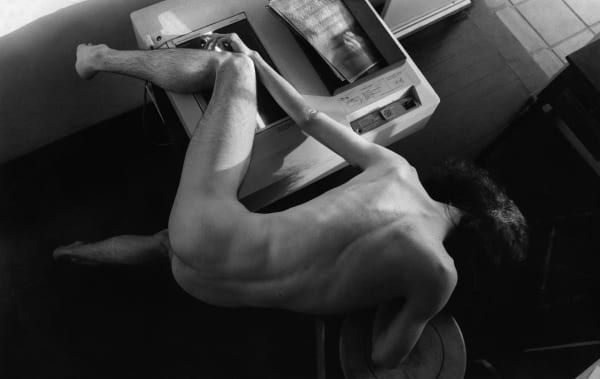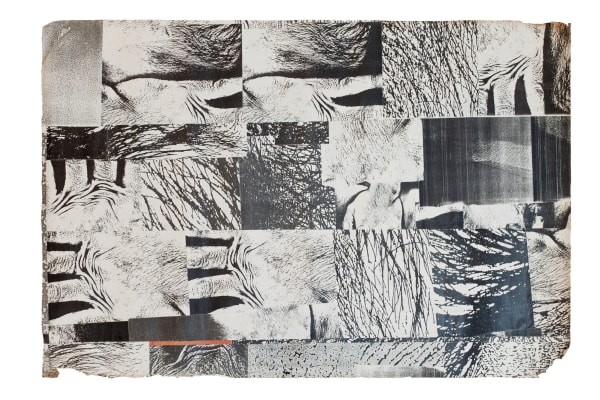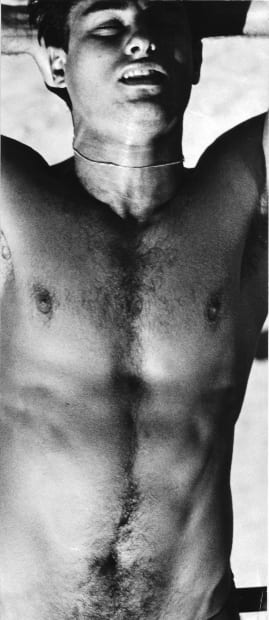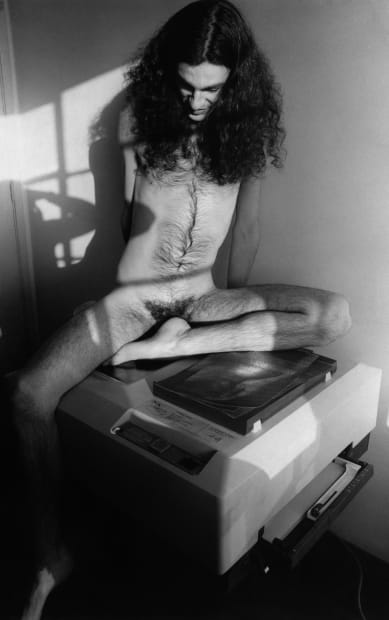-
Let X=X: Alair Gomes and Hudinilson Jr.
19 June - 17 July 2021 -
-
-
-
Symphony of Erotic Icons
‘I insisted so much in liberating the erotic - often it can be called pornographic; I never denied the possibility that my photography could be called pornographic - that, suddenly, certain categories were transcended.’
Alair Gomes
Symphony of Erotic Icons is Alair Gomes' most ambitious series. Composed exclusively with pictures of beautiful, young male bodies, the Symphony consists of 1767 photographs in which the male body appears either whole or fragmented, portrayed sometimes in classical, sometimes in unusual angles. His objective is to create, through a saturation of images, an effect of distance from the materiality of the body, in which the pores and skin should no longer be seen as fragments of the body, but rather as an evolution of cosmic images.
Alair Gomes on Symphony of Erotic Icons
‘My obsession with the male body must be understood also in very direct, very literal terms. I wanted to produce a greater number of images of this kind, I was feeling almost suffocated by the image of the beautiful, young, male body. At the beginning, this almost irresistible tendency to produce large quantities of images was in contradiction with the desire to produce a very perfect, very elaborate photographic image. (...) Many times I came to think that if I insisted enough in photographing the young male body, taking simply a vast number of shots of that image in different situations (...) perhaps this accumulation of a fantastic number of images of the young male body in different situations could ultimately function as a kind of vision of the world, a Weltanschauung, from an almost philosophical point of view.’
‘So, as I considered the tremendous potential of composition in painting in relation to that of the photographic image, this very superior control a painter has over the image compared to photography, and as I considered also my tendency to take almost obsessive shots, I must have understood that my ambitious path in photography had to be the path of sequential photography instead of that of the single image.’
‘Taking multiple images gave me the impression that I was using a resource of photography that painting did not have. By that I mean precisely the capacity to turn a succession of several images of the same subject, all very similar, into something new, so that each one shows a certain novelty, something interesting that is worth observing and emphasizing.’
‘It was necessary to explore the potential, this photographic genre, and to reveal different yet very close aspects of the same subject, as each one has its own characteristics which deserve to be emphasized.’
‘The collection had to be structured to form a sequence. From that I saw that my problem in exploring photography was very close to the problem faced by cinema. Because cinema, in reality, is a composition based on a sequence of various images - the image moves for a while and is accompanied by sound. Photography does not exactly need sound because it does not have movement. This creates huge differences between a series, a sequence, a still, and the problem faced by cinema. But the relationship is clear.’
‘I simply chose the sequence - on the one hand, my obsession, a tendency to repeat the image; on the other, the idea that treating the multiple image offers the possibility of exploring a potential of photography which is unavailable to painting. This means photography can be made more independent from painting. When, for example, you present a huge quantity of photos which in isolation do not obey any of the values of photographic composition, and yet can contribute greatly to a sequence by adding meaning to it, no longer in relation to a single image but as part of a sequence.’
-
HUDINILSON JR. - XEROX ACTION
"Through the broadening of bodily details and skilled technical mastery, Hudinilson Jr. superseded the tool’s usual range in those times already filled with excitement over the relatively new medium of Xerox art: he achieved what he called Xerox Actions."
Paulo Myiada, To Caress, To Fondle, To Covet: Hudinilson Jr. in Mousse, Summer 2020
"As Ricardo Resende asserts in what is to date the most thorough piece of writing on the artist, if Hudinilson Jr. ever created a masterpiece, it is Narcisse Exercício de Me Ver II (Exercise of Seeing Myself II, 1982), a work whose making was photographically recorded by Afonso Roperto and was later given the status of a performance. Stark naked, the artist, who was already intimate with the photocopier, having relentlessly tested its resources and limits, climbed onto the glass top and transformed his own hairs, protuberances, and orifices into a matrix to be scrutinized by the mechanical light. Knowing that the voids would be translated into the toner’s dense black, he tried positions that were alternately more or less revealing, multiplying enlargements and subdividing his image into modulations. He executed a choreography in which the reproductive, serial machine repeated its movement and he improvised variations."
Paulo Myiada, To Caress, To Fondle, To Covet: Hudinilson Jr. in Mousse, Summer 2020
-
Interview with Hudinilson Jr. conducted between 2011 and 2013 by Vitor Butkus.
-
LIST OF WORKS
-
 Hudinilson Jr., Untitled, 1982
Hudinilson Jr., Untitled, 1982 -
 Hudinilson Jr., Untitled, 1982
Hudinilson Jr., Untitled, 1982 -
 Hudinilson Jr., Untitled, 1980s
Hudinilson Jr., Untitled, 1980s -
 Hudinilson Jr., Caderno de Referências nº 27, 1980/2000s
Hudinilson Jr., Caderno de Referências nº 27, 1980/2000s
-
 Hudinilson Jr., Caderno de Referências XII, 1980/2000s
Hudinilson Jr., Caderno de Referências XII, 1980/2000s -
 Hudinilson Jr., Caderno de Referências XX, 1980/1980s
Hudinilson Jr., Caderno de Referências XX, 1980/1980s -
 Hudinilson Jr., Xerox-Action, 1979/1980
Hudinilson Jr., Xerox-Action, 1979/1980 -
 Alair Gomes, Symphony of Erotic Icons #14, 1966 to 1978
Alair Gomes, Symphony of Erotic Icons #14, 1966 to 1978
-
 Alair Gomes, Symphony of Erotic Icons #24, 1966 to 1978
Alair Gomes, Symphony of Erotic Icons #24, 1966 to 1978 -
 Alair Gomes, Symphony of Erotic Icons #25, 1966 to 1978
Alair Gomes, Symphony of Erotic Icons #25, 1966 to 1978 -
 Alair Gomes, Symphony of Erotic Icons #17, 1966 to 1978 Sold
Alair Gomes, Symphony of Erotic Icons #17, 1966 to 1978 Sold -
 Alair Gomes, Symphony of Erotic Icons #32, 1966 to 1978
Alair Gomes, Symphony of Erotic Icons #32, 1966 to 1978
-
 Alair Gomes, Symphony of Erotic Icons #26, 1966 to 1978
Alair Gomes, Symphony of Erotic Icons #26, 1966 to 1978 -
 Alair Gomes, Symphony of Erotic Icons #6, 1966 to 1978
Alair Gomes, Symphony of Erotic Icons #6, 1966 to 1978 -
 Alair Gomes, Symphony of Erotic Icons #2, 1966 to 1978
Alair Gomes, Symphony of Erotic Icons #2, 1966 to 1978 -
 Alair Gomes, Symphony of Erotic Icons #1, 1966 to 1978
Alair Gomes, Symphony of Erotic Icons #1, 1966 to 1978
-
-
ALAIR GOMES
Born on December 20, 1921 in Valença, Alair de Oliveira Gomes obtained a degree in civil engineering in 1944 at the University of Brazil, Rio de Janeiro. The following year, he was appointed an engineer at the Brazilian Railway Company. He founded the literary review, MAGOG, with José Francisco Coelho and a few other friends in 1946. The same year, he underwent a profound religious crisis.
In 1948, he abandoned his profession as an engineer to devote himself to the study of modern physics, mathematics, and biology. In 1961, he received a philosophy grant from the Guggenheim Memorial Foundation. He spent one year in the United States (1962-1963), where he was invited to teach at Yale University. From 1964 to 1976, he participated in numerous international conferences on the philosophy of science. He became a professor of Philosophy of Science at the Biophysics Institute of the Federal University in Rio de Janeiro and a professor of contemporary art at the School of Visual Arts (Brazilian Ministry of Culture), and then, an advisor at the National Institute of Visual Arts (National Foundation for the Arts, Rio de Janeiro).
From 1977, Gomes became more active in the fields of art criticism and photography. Between 1976 and 1984, he exhibited his photographs in New York, Paris, Rio de Janeiro, and Toronto. He was murdered in 1992 in Rio de Janeiro.
-
-
HUDINILSON JR.
Hudinilson Urbano Jr. was born in São Paulo in 1957. Between 1975 and 1977 he studied visual arts at Fundação Armando Álvares Penteado – FAAP, having dropped out before completing his degree. In 1979 he founded with artists Rafael França (1957–1991) and Mário Ramiro (1957) the group 3NÓS3, which made artistic interventions in the city of São Paulo up to 1982. Between 1975 and 1981, he coordinated Xerography Hub at the Pinacoteca do Estado de São Paulo, where he enabled the production of practical, theoretical and editorial works in that medium.
From the early 1980s he developed an extensive and pioneering body of works using photocopy machines as an artistic medium. Hudinilson often used his own body in his works, placing different body parts against the machine’s scanner and manipulating the resulting images to create multi-panel wall pieces displayed in grid-like structures. The strong orthogonal presence of the grid in these works evokes the constructivist legacy of late Brazilian modernism; however geometry features here in stark contrast with images of the nude male body. Produced at a time when the country was still under a military dictatorship and queer bodies were being decimated by the AIDS pandemic, these fragmented works also seem to refer to bodies whose integrity is dangerously under the threat of political repression and disease.
Hudinilson's first intitutional exhibition took place at the Pinacoteca do Estado de São Paulo in 1981. In 1984, he took part in the 1st Havana Biennale and in the exhibition Arte Xerox Brasil, held at Pinacoteca de São Paulo and curated by himself. His work was also exhibited at the 16th and 18th São Paulo Biennales (1981 and 1985) and at the 3rd Mercosur Visual Arts Biennale in 2001. Following his untimely death in 2013, Hudinilson's work has been widely exhibited in several international exhibitions including the 31st São Paulo Biennial (2014), Glasgow International (2014), Cantor Arts Centre - Stanford University (2018), and Migros Museum (2019).
His works are present in important collections including MoMA (New York, EUA), Museu Reina Sofia (Madrid, Spain), Migros Museum (Zurich, Switzerland), MAGA Museo d’Arte (Gallarate, Italy), MALBA (Buenos Aires, Argentina), MASP (São Paulo, Brazil), Pinacoteca do Estado (São Paulo, Brazil.
-

























